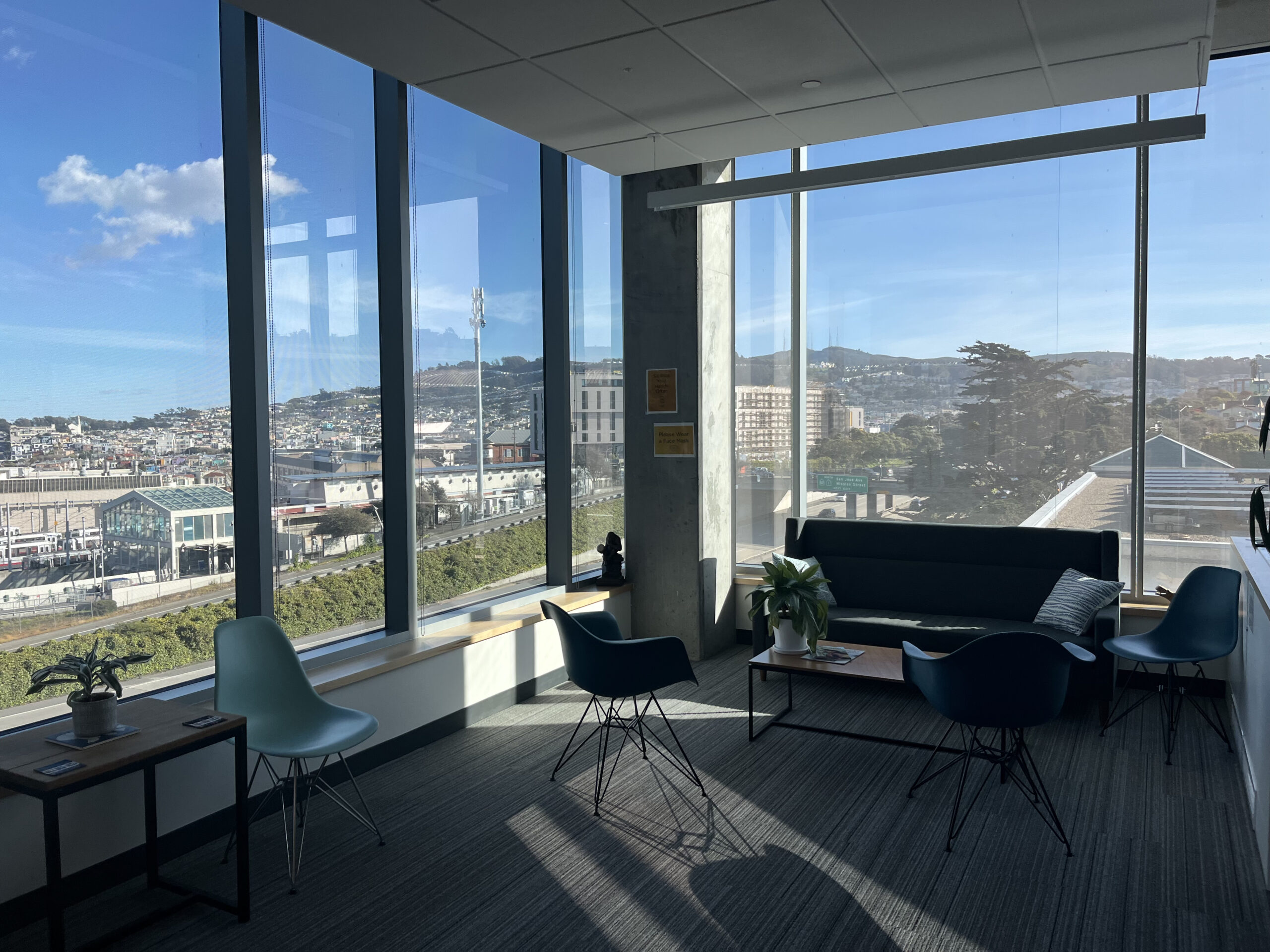Prospective Lick-Wilmerding High School students are often captivated by esteemed college preparatory programs, and the college counseling process is quintessential to the LWHS student experience. Simultaneously, BIPOC, first-generation to college and flexible tuition students undergo unique experiences navigating college admissions. As they do so, these constituents of the LWHS community grapple with the institution’s commitment to equity amidst growing nationwide conversations about college accessibility.
For nearly all students at LWHS, college counseling begins in junior year, when students are paired with one of three counselors to guide them along their college process: Alayne Haggerty, Gabriela Mejia and Krista Klein. Marie Shapiro is the Administrative Assistant of College Counseling, while Haggerty and Klein work as co-Directors with Mejia as an Associate Director. “That’s been how we’ve maintained the program — as a co-directorship and partnership among the three of us,” Haggerty said. “We’re in a place of transition,” Mejia added. Each counselor mentors between 40 and 45 students, and the department is overseen by Kate Wiley, Dean of Teaching & Learning.
During their junior year, LWHS students and counselors begin with preliminary meetings for counselors to get to know their students and draft potential college lists based on interests, academic performance, extracurriculars and identity. These meetings lay the foundation for senior year when counselors work with students to refine college lists, revise essays and write letters of recommendation. “Writing letters of recommendation is one of my favorite parts of the process. It’s also work-intensive — we’re getting to know students and writing about them to colleges,” Haggerty said.
While conversations regarding college accessibility both at LWHS and nationwide often spotlight admissions choices made by universities, just applying to college from high school can be a substantial endeavor. This holds especially true for those systemically marginalized such as students who are reliant on financial aid or members of working-class families, first-generation applicants and BIPOC students.
“While some families can afford private tutors and college counselors for their kids, others struggle just to pay the application fees,” Sarah McCammon reported in 2020 for NPR’s Weekend Edition Segment, When Applying for College is Especially Difficult. According to the same NPR program, disparities can also manifest themselves in application questions, which can create a greater disconnect for BIPOC and lower-income applicants. These applicants may have less access to activities considered “elite” or “impressive,” such as expensive summer education programs, internships found through personal/familial connections or costly global stewardship opportunities.
At LWHS, 33% of students receive financial aid. Furthermore, about 66% of LWHS students identify as BIPOC and according to Mejia, about 10% of the class of 2023 is first-generation college bound. While LWHS strives to be an equitable institution, these factors ultimately affect college accessibility for these students.
“I’ve had a really good and positive experience with college counseling. I had Gabriella … I felt like I was able to share a lot about myself and she became one of those trusted adults on campus for me,” George Duran ’23, a first-generation, BIPOC student on financial aid said.
“There have been a lot more unknowns than I thought there would be,” Julieta Lamm-Perez ’23, a BIPOC student on financial aid said, referring to the process overall.
While the college admissions landscape — as well as LWHS’ student body — alters every year, some alumni and current students share similar sentiments.
“I felt supported [as a junior]. with all the meetings and presentations beginning as a junior around what to expect in the college process. It was great that we were paired with one of the college counselors so we could work one-on-one with them. I think the biggest challenges I faced in the process came at the beginning [of senior year]. I don’t think I fully understood what needed to be done so early on.” Naima Blanco-Norberg ’21, a BIPOC alumni on financial aid said.
At LWHS, resources for these students are layered. Some, like fee or SAT waivers, tend to be more standardized. “Application fee waivers are something we’ve tried to be very transparent about with our students from their first meetings. We base these off flexible tuition, which we found out this year isn’t always the greatest indicator, but a good one in most cases. It allows access to schools that students maybe wouldn’t have applied to if they had to pay a $90 application fee, for example,” Mejia said.
Thinking back to his experiences as a BIPOC student on financial aid, Adrián Blanco ’23 said, “I got fee waivers for the Common App schools. Nothing for the UCs even though I’ve heard that you can get them reimbursed. I can maybe follow up with that.”
Senior workshops are another integrated program. Workshops about the Common Application Personal Statement, the educational background and grading sections of the Common Application and UC applications were required for the class of 2023 and took place during free blocks. On the other hand, those regarding interviews, merit & need-based aid and California State University (CSU) applications were optional, less advertised and took place during tutorials.
“I couldn’t go to the financial aid workshop because I had a meeting during tutorial… it was really confusing to figure it out [later]… if the workshop was something we had to go to, then at least everyone would know it was happening,” said Lamm-Perez.
This year, opt-in workshops for first-gen students were also offered during lunches. “It was nice, having that time to work on things, and to have them be there … they were there in case you had questions,” a BIPOC, first-gen and financial aid receiving anonymous interviewee in the class of 2023 said. “But aside from that, it was basically just writing essays in a classroom… I procrastinated so hard that I didn’t even know what questions I would need to ask.”
Among barriers encountered, financial ones are often some of the most significant. Furthermore, BIPOC and first-gen students with financial needs may find their barriers to college accessibility compounded. For the over one-third of LWHS students currently receiving financial aid, pathways to college financial aid or need-based scholarships may differ greatly.
“As a first-gen student, I was super, super overwhelmed… I just didn’t know where to start … in addition to being a BIPOC student and a financial aid student, it’s very discouraging… despite the fact anyone who applies from this institution is already coming from a massive place of privilege… There didn’t seem like there was a lot that was specifically curated to the first-gen experience,” the anonymous interviewee said.
Mejia worked for a Community-Based Grassroots Organization that specifically mentored first-gen Black and Latinx students applying to college for 12 years before working at LWHS, and she shared her strategies when approaching support needs. “I think my first-gen, BIPOC and low-income students will kind of move to the top of my list [of emails or questions] because I know that if they don’t meet with me, they’re not going to have someone they can go home and ask that question to,” Mejia said. “As the only Latina and person of color in this department, I think that when I work with Latinx students or other underrepresented students, such as students of color, there are some shared experiences… That might be even more significant at a PWI (Predominantly White Institution),” she said.
While this connection cannot be generalized to all BIPOC students, it resonates with some. “[As a first-gen, BIPOC and financial aid student] I knew I had to work twice as hard to work through the process… I knew that there were a lot of unknowns that I didn’t know about the college process that I had to figure out with the support of my college counselor. It actually really helped that my college counselor also identified as BIPOC too,” Fernanda Sanchez ’23 said.
“My college counselor… encouraged me to go for opportunities that I didn’t think I was qualified for and helped me tackle impostor syndrome as a working-class first-gen BIPOC student,” the anonymous interviewee said.
Thinking about how identity-based connections can impact experience, the anonymous interviewee also shared their outlook. “I definitely think that other counselors were aware of situations, but that that may not have come with as much sort of emotional or technical understanding,” they said. “For example, I received a lot of information about fly-in programs early enough in the process — I was fortunate to be able to participate in that. I also communicated with some peers (mentored by other counselors) who were not aware that fly-in programs even existed.”
When it comes to formal, annually issued aid, there’s the Free Application for Federal Student Aid (FAFSA), which uses tax returns to calculate an Estimated Financial Need (EFC). Most students begin filling out this form with their families any time from the summer after their junior year to the fall quarter of their senior year. The College Scholarship Service (CSS) profile, which asks for more specific info and is generally self-reported, is also usually filled out at this time. Most private colleges and some larger state schools require both to be eligible for financial aid.
A slightly lesser-known aspect of the process, the Institutional Documentation Service (IDOC), is a portal available through the CSS upon which colleges request additional documents. Almost all financial aid-seeking students will be asked to submit at least a few supporting documents, including specific tax returns — these also come with their own deadlines. More documents are requested when specific exceptional financial circumstances are reported, or if a student’s family owns a small business (or farm).
Additionally, students may still have to pursue scholarships out of genuine financial need not covered by the FAFSA or schools’ financial packages. This entails its own process with additional supplementary essays, letters of recommendation and transcripts generally due soon after applications are sent to colleges (though some are outliers, due in fall or summer).
“I’m BIPOC and on financial aid, but I’m not first-gen,” shared Lamm-Perez. “There were times when some of the applications were so confusing, and my parents didn’t know the answers.I felt very stuck, I didn’t know what else to do… there wasn’t really communication about financial aid… I didn’t know that schools ask for special documents, or that the deadlines are super different. I missed some of my deadlines, which is not great.”
“I missed a bunch of scholarship deadlines because I hadn’t heard about them before… It was also challenging as a student applying to college knowing that I would need to find outside resources to pay for my education. There were barely any resources or support on applying to scholarships and grants,” Blanco-Norberg said.
Conversations about students’ needs may be complicated by statements made on the official LWHS website that the school already supports “students from all backgrounds” or is already upholding “the tenets of anti-racism to interrupt all forms of interpersonal and institutional bias and discrimination.”
“This is a thing that I’ve seen come up in my classes… that the school environment is not very transparent when it comes to class and socio-economic disparities. I think the way that translated into financial aid discussions is that there was so little visibility about financial aid, sort of on a cultural level,” the anonymous interviewee said.
Aside from the details of the college application, disparities can arise in other aspects of the college process — some of which are somewhat unique to elite independent schools such as LWHS. One example includes outside-of-school resources, which can raise questions of equality versus equity.
Alumni Indigo Mudbhary ’22 shared her experiences with these factors. “I feel like there’s this unaddressed elephant in the room when it comes to college counseling, which is that a significant portion of the grade hires outside essay help for significant amounts of money. I feel like the college counseling department never talks about it explicitly. I know many of my friends used outside support … it’s more about how society is structured that some people get access to help, not individuals’ faults,” she said.
“I don’t know how the college counseling department would address that or account for that inequality, but it’s honestly, just a little embarrassing that we all tiptoe around the issue. I feel like the department has a responsibility to account for that inequality,” she said.
Yet, counselors shared that additional complications that may arise, citing why students at LWHS are not asked about outside-of-school assistance. “We don’t typically [ask if students have private assistance] because sometimes students don’t even know that’s an option… I would like my students to be transparent … it can create awkwardness and I try to avoid creating these types of situations,” Mejia said.
As college counseling looks to the future, the LWHS counselors shared that they anticipate changes within the department. “A lot depends on what the new (LWHS) leadership expects from our office … And at the same time, we’re keeping in mind that the world of college admissions is something that changes every year. We have to be responsive to the ways in which the national landscape is shifting,” Mejia said.
With differing experiences and outlooks, the college counseling department remains a key aspect of the student experience at LWHS. As LWHS strives to embody equitable and anti-racist policies, students reflect, voicing appreciation, concerns and questions of opportunity.







